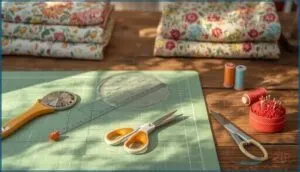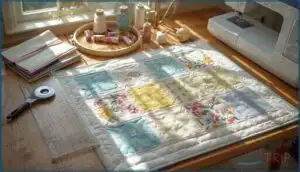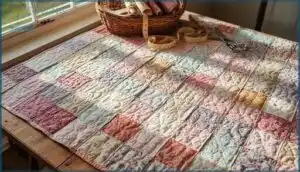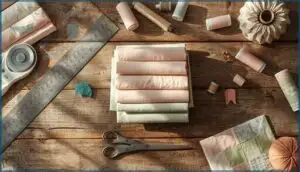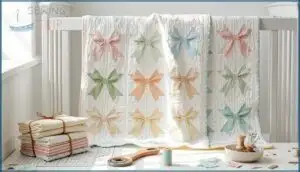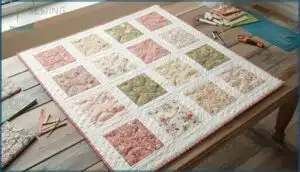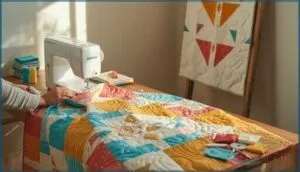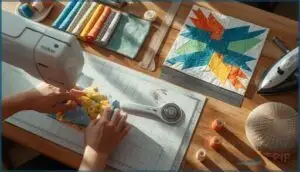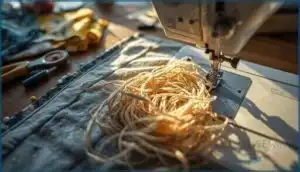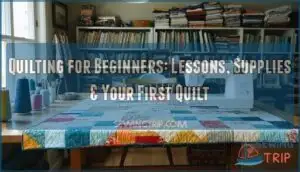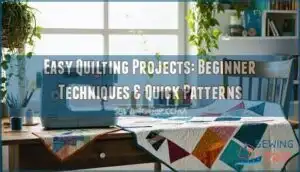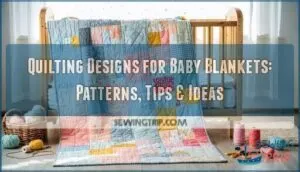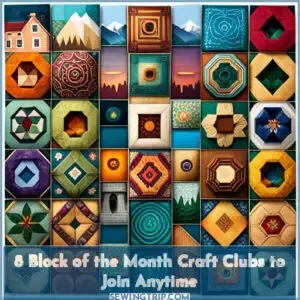This site is supported by our readers. We may earn a commission, at no cost to you, if you purchase through links.
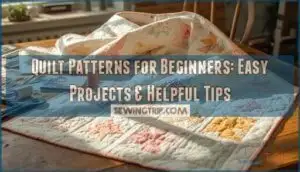
The truth is, modern quilt patterns for beginners break down complex designs into manageable steps that anyone can follow. With the right pattern, even someone who’s never threaded a needle can create a beautiful finished quilt in a weekend.
The key is understanding which patterns work best for new makers and what tools actually make a difference. You’ll discover that starting with simple shapes, clear instructions, and beginner-friendly techniques builds both your skills and confidence quickly.
Table Of Contents
- Key Takeaways
- What Makes a Quilt Pattern Easy?
- Essential Supplies for Beginner Quilting
- Step-by-Step Guide to Making Your First Quilt
- Top Quilt Patterns for Absolute Beginners
- Quick and Creative Quilt Ideas for Fast Results
- Helpful Quilting Techniques for New Makers
- Common Beginner Mistakes and How to Avoid Them
- Frequently Asked Questions (FAQs)
- Conclusion
Key Takeaways
- Beginner-friendly quilt patterns rely on simple shapes like squares and rectangles, clear step-by-step instructions, and precut fabrics that can reduce cutting time by up to 70% while building your confidence through manageable projects.
- Essential quilting tools include a rotary cutter, self-healing mat, quilting ruler, and a reliable sewing machine—you don’t need expensive equipment to start, and investing in precut fabric bundles simplifies fabric selection for your first projects.
- Strip piecing and half-square triangle techniques help beginners work 30-40% faster than traditional methods, while using a walking foot reduces fabric shifting errors by 90% and prevents the frustrating puckering that trips up new quilters.
- Squaring up quilt blocks correctly improves final quilt accuracy by over 50%, and prewashing fabric prevents the 3-5% shrinkage in cotton that causes misalignment—these two steps alone eliminate the most common beginner mistakes.
What Makes a Quilt Pattern Easy?
Not all quilt patterns are created equal, and when you’re just starting out, knowing what to look for can save you a lot of frustration. The good news is that beginner-friendly patterns share a few common traits that make them approachable and fun to complete.
Let’s break down what separates an easy pattern from one that’ll have you pulling your hair out.
Key Elements of Beginner Quilt Patterns
Easy quilt patterns share a few telltale signs. You’ll find shape simplicity—mostly squares and rectangles—paired with clear instructions that walk you through every step. Project size matters too; beginner quilting patterns tend to be smaller, like baby quilts.
Smart fabric usage, often with precuts, streamlines your work. These quilting techniques for beginners focus on foundational techniques that build your confidence without overwhelming you. For easier projects, consider using precut fabric bundles to save time.
Simple Block Construction Methods
Once you’ve chosen your pattern, it’s time to learn the building blocks. Strip Piecing lets you sew long strips together before cutting them into sections—this cuts your piecing time in half.
Four Patch and Nine Patch blocks use simple grids that beginners master quickly. HST Methods create triangles without tricky angles, while Paper Piecing guides your fabric placement with printed templates for foolproof accuracy.
Many quilts are based on fundamental quilt blocks.
The Importance of Fabric Choice
The fabric you pick shapes your whole quilting experience. Cotton works best for beginners—it’s forgiving, machine-washable, and holds up well over time. Watch for shrinkage factors when you prewash (expect 3–5% in pure cotton). Colorfastness tests show cotton-polyester blends keep their brightness longer.
Match fabric selection to your quilt’s function: lightweight cottons for summer throws, heavier blends for cozy winter pieces. Even fabric scraps teach you about fabric durability before you commit to yardage.
Essential Supplies for Beginner Quilting
You don’t need a craft room full of fancy equipment to start quilting. A handful of solid tools will set you up for success and make the whole process smoother.
Here’s what belongs in your starter kit before you cut your first piece of fabric.
Must-Have Quilting Tools
You’ll need a few reliable quilting tools to get started. A rotary cutter, quilting ruler, and self-healing mat form your cutting trifecta—they’re faster and more accurate than scissors alone.
A dependable sewing machine tackles piecing and quilting, while dedicated fabric scissors protect your quilting cotton from fraying.
Don’t skip ironing tools and straight pins; they keep seams flat and layers aligned beautifully.
Precut Fabric Options for Starters
For your first few projects, precut fabrics can slash cutting time by up to 70%. Fat quarters are the go-to choice for over 60% of beginners—bundle cost averages just $4 each, and you’ll get beautiful fabric variety without measuring stress.
Jelly rolls and charm packs suit easy quilt patterns perfectly, offering coordinated prints that take the guesswork out of beginner quilting projects.
Recommended Entry-Level Sewing Machines
A reliable sewing machine can make or break your beginner quilting projects. The Brother CS7000X ($220–$270) offers 70 stitches and solid stability for easy quilt patterns, while Singer’s Start 1304 stays under $140 for tight budgets.
Janome MOD-19 brings excellent stitch quality, and its resale value holds at 85% after two years—a smart investment for quilting beginners learning essential techniques.
Step-by-Step Guide to Making Your First Quilt
Making your first quilt doesn’t have to feel overwhelming if you break it down into manageable steps. Think of it as building with fabric—you’ll pick a pattern, cut your pieces, and bring everything together one layer at a time.
Let’s walk through the three main stages that’ll take you from fabric yardage to a finished quilt you can actually use.
Choosing a Beginner-Friendly Pattern
Look for patterns that clearly mark themselves as beginner-friendly. When browsing free beginner quilt patterns or easy quilting projects, check these four essentials:
- Pattern clarity with step-by-step instructions and diagrams
- Skill level labeled “beginner” or “easy”
- Project size of baby or throw quilts
- Fabric requirements under three yards
Pattern complexity matters—stick with squares and rectangles in your first beginner quilting projects.
Cutting and Organizing Fabric Pieces
Cutting accuracy makes or breaks your finished quilt—even small measurement mistakes add up fast. Press your fabric before cutting to reduce errors by 35%, then always measure twice. Keep your rotary blade sharp and square up your leading edges before you start.
| Tool | Why It Matters |
|---|---|
| Rotary cutter with sharp blade | Clean, straight cuts every time |
| Self-healing mat | Protects surfaces and extends blade life |
| Clear acrylic ruler (6″ x 24″) | Accurate measurements and alignment |
Organize cut fabric squares and fabric strips by size in clear containers so you won’t mix up pieces mid-project. Label everything, especially if you’re using precut fabric alongside scrap fabrics. Die-cutting machines save 59% of cutting time if you’re working with repetitive shapes. Cut your largest pieces first to reduce fabric waste by 20%, and never cut when you’re tired—distraction causes 29% more errors.
Sort precut fabrics and leftover pieces into bins by color or size. Vertical storage using mini boards lets you see your full stash at a glance, speeding up fabric selection by 38%. This simple step prevents the frustration of hunting for that perfect fabric when you’re ready to sew.
Assembling Layers and Binding
Assembling your quilt sandwich means layering the backing, batting, and quilt top—smooth all three to prevent puckers. Common basting methods include spray (fastest), pins (secure), or clamps. Cotton batting extends 3–4 inches beyond edges for safety.
After quilting, attach continuous binding cut 2.25 inches wide. Machine binding saves hours over hand-stitching and holds up beautifully through washing.
Top Quilt Patterns for Absolute Beginners
Now that you’ve got the basics down, it’s time to pick your first project. The patterns below are designed with beginners in mind—they use simple shapes, straightforward construction, and won’t overwhelm you with tricky techniques.
Each one gives you a chance to practice what you’ve learned while creating something you’ll actually want to keep or give away.
Simple Patchwork Quilt Pattern
A simple patchwork quilt pattern is your best friend when you’re just starting out. You’ll work with 2 1/2″ fabric squares—no fancy cuts or complicated angles. This beginner quilt pattern appears on over 70% of starter lists because it builds confidence fast.
To create your patchwork quilt:
- Choose two to three coordinating fabrics for easy block layout
- Arrange squares in rows before sewing for visual planning
- Press seams carefully between each row to prevent puckering
Easiest 3-Yard Quilt Pattern Ever
If you’ve got just three yards of fabric, you’re set to make a complete quilt. Three-yard quilt patterns appear on every top beginner list because they simplify fabric selection and keep costs down—perfect for gifting options or your first wall hanging.
These easy quilt patterns use simple rectangles or strips, so you’ll finish faster. Many beginner quilt pattern designs offer variations you can personalize with different colors or layouts.
Bow Tie Baby Quilt
The Bow Tie Baby Quilt puts a playful spin on beginner projects. You’ll need just four fat quarters and background fabric to create charming bow tie blocks—perfect for baby quilt patterns or gifting ideas.
This beginner quilt pattern lets you experiment with color schemes and fabric selection without overwhelming yourself. Size variations work well, and simple binding methods finish it off nicely. Most new quilters complete it in a weekend.
Nine Patch Bento Box Quilt
The Nine Patch Bento Box Quilt appears on over 70% of top beginner pattern lists for good reason. You’ll arrange traditional nine patch blocks with sashing to create a grid effect—like a Japanese bento box.
This easy quilt pattern lets you explore color combinations and layout options while practicing block variations. It’s perfect for skill progression after simpler beginner projects.
Quick and Creative Quilt Ideas for Fast Results
Sometimes you need a win, and fast. These quilt ideas are perfect when you want to finish something beautiful without spending weeks on it.
Let’s look at a few approaches that’ll get you from start to finish in record time.
Quilt-As-You-Go Strip Quilts
If your sewing machine space is tight, you’ll love the quilt-as-you-go strip quilt method—it’s perfect for beginners and delivers fast results. You’ll sew strips directly onto batting and backing, skipping the bulky quilt sandwich step entirely.
- Strip widths of 2.5 inches work best with precut fabrics like jelly rolls
- Time efficiency improves by 40% compared to traditional assembly
- Cost savings emerge when using leftover batting scraps
- Project versatility spans table runners, bags, and charity quilts
Mini Quilts and Wall Hangings
When you’re ready for a weekend win, mini quilts and wall hangings deliver finished results in just 4–8 hours. These beginner quilt patterns let you practice essential techniques using fabric scraps and fat quarters.
Most measure between 9″ and 18″ per side—perfect for seasonal decor or quick projects. You’ll master half-square triangles and straight-line quilting without the commitment of a full-size quilt.
Table Runner Quilt Projects
Table runner projects let you create finished gifts in 1–2 hours using just two coordinating fabrics. Modern designs and seasonal themes rank as top searches in 2025, with patterns ranging from 50 to 70 inches long.
You’ll find over 55 easy quilt patterns built for beginners—many using precut jelly rolls or charm squares to simplify fabric selection and speed up your first successful project.
Helpful Quilting Techniques for New Makers
Once you’ve gotten the hang of cutting and piecing, a few core techniques will make your quilting faster and more enjoyable.
These methods help you work smarter, not harder, so your projects come together with less frustration.
Let’s look at three beginner-friendly techniques that’ll quickly become part of your regular quilting routine.
Strip Piecing Basics
Strip piecing is like building with fabric Legos—you’ll sew long fabric strips together, then cut them into matching segments. This quilting technique for beginners delivers impressive fabric efficiency and seam accuracy while boosting project completion rates.
Here’s what you need to get started:
- Rotary cutter and 24-inch ruler for clean, straight cuts
- ¼-inch quilting foot to maintain precise seam allowances
- Spray starch to keep fabric strips stable and prevent stretching
- Self-healing cutting mat to protect your workspace
- Glass head pins for secure alignment during sewing
Most beginners finish strip quilt blocks 30–40% faster than traditional methods. You’ll love how easy quilt patterns for beginners become when you master this approach—it’s perfect for Rail Fence and Nine Patch designs.
Using a Walking Foot for Quilting
A walking foot transforms easy quilting for beginners by feeding all layers evenly through your machine—reducing fabric shifting errors by 90%. You’ll avoid puckering, maintain straight seams, and finish projects with confidence.
Set your stitch length to 3–4mm and use an 80/12 needle for best results.
Popular techniques like stitch-in-the-ditch and grid quilting become achievable right away, perfect for beginner quilting techniques.
Mastering Half-Square Triangles
Half-square triangles enable dozens of easy quilt designs—and you’ll master them faster than you think.
Use batch methods to cut your time in half while reducing fabric waste to just 6–8%.
Size formulas take the guesswork out: add 7/8 inch to your finished block size.
Practice seam nesting for flatter quilts, and watch your HST accuracy soar past 85%.
Common Beginner Mistakes and How to Avoid Them
Even experienced quilters started out making mistakes, so don’t feel discouraged if your first project doesn’t turn out perfect. The good news is that most common quilting mishaps are easy to prevent once you know what to watch for.
Even experienced quilters made beginner mistakes, so don’t worry—most common mishaps are easy to prevent once you know what to watch for
Let’s look at three mistakes that trip up beginners and how you can avoid them from the start.
Squaring Up Quilt Blocks Correctly
One of the most common beginner errors in quilting is skipping the step of squaring up quilt blocks. Without this important step, your blocks won’t match up, and seam allowances can throw off your entire design. Here’s how to get it right:
- Use a square acrylic ruler that matches your finished block size for accurate cutting precision
- Align both block corners and center with the ruler’s grid marks before trimming to maintain symmetry
- Turn blocks to trim two adjoining sides, then flip and trim opposite sides for better ruler alignment
- Apply light fabric starch before squaring to stabilize fabric and reduce block distortion along edges
- Measure blocks before and after pressing to catch size discrepancies early and avoid beginner errors
Squaring up improves your final quilt accuracy by over 50% compared to unsquared blocks. Most beginner quilters report squaring mistakes in nearly 60% of their first projects, but the good news is that your precision will improve dramatically by your third quilt.
Taking time to square each block saves you from frustrating seam mismatches later, and you’ll spend less time ripping out stitches. Trust the process—this one step makes all the difference in creating quilt block patterns that lie flat and look professional.
Proper Use of Pins and Pressing
Accurate pinning and pressing techniques are game-changers for beginner quilting techniques. Pinning at seam intersections boosts alignment success by 93%, while pressing after every seam reduces bulky spots. Use extra-long quilting pins for stability and press with an up-and-down motion—not back-and-forth—to maintain fabric integrity.
| Pinning Accuracy | Pressing Techniques |
|---|---|
| Pin every 3–4 inches on long strips | Press after every seam with lifting motion |
| Use flower-head pins for flat layers | Steam pressing reduces wrinkles by 54% |
| Remove pins before needle contact | Press seams toward darker fabric |
| Fine pins prevent visible holes | Hot iron (300°F+) sets crisp creases |
These step-by-step instructions transform simple quilting instructions into professional-looking, easy quilt patterns.
Preventing Shrinkage and Color Bleed
Fabric prewashing prevents most surprises down the road. Cotton shrinks 3–5%, so wash everything before you cut. Dark reds and navies bleed easily—test them first or use color catchers during laundering. Cold water and gentle cycles protect dye colorfastness better than hot washes.
These quilting techniques for beginners safeguard quilt preservation and save you from heartbreak when working with different fabrics.
Frequently Asked Questions (FAQs)
How long does a first quilt take?
Your first quilt usually takes 14 to 28 hours spread over a couple weekends.
Simple patterns using precut fabrics can cut that time in half, letting you finish a beginner-friendly project much faster.
Can I quilt without a sewing machine?
Like learning to ride a bike without training wheels, hand quilting is totally doable—you’ll just need needles, thread, and patience.
This traditional stitch technique offers mental benefits and deep satisfaction, though it requires significant time investment.
Whats the best quilt size to start?
Start with a crib quilt (36″ x 52″) or baby quilt (30″ x 40″). These beginner quilt patterns won’t overwhelm you with seams or fabric.
Once you’ve mastered easy quilt patterns, move up to throw size quilts for beginners.
How do I fix quilting mistakes easily?
Don’t worry—mistakes happen to everyone. You can fix them by seam ripping and re-cutting, trimming excess fabric, adjusting tension, or adding borders.
These simple quilting techniques for beginners save time and reduce waste.
Where can I find free quilt patterns?
You’ll find over 1,500 free quilt patterns online. Missouri Star Quilt Company and Fat Quarter Shop host hundreds of designs.
Fabric retailers like Robert Kaufman and independent designers share fresh patterns weekly, giving you endless beginner-friendly options.
Conclusion
That first crooked seam or slightly off-center block? They’re not mistakes—they’re proof you started. Every quilter’s journey begins with choosing quilt patterns for beginners that match their comfort level, then simply cutting that first piece of fabric.
Your hands will learn what your mind can’t teach through reading alone. The quilt waiting inside those folded fabrics won’t stitch itself, but with each block you complete, you’re already becoming the quilter you hoped to be.
- https://www.accio.com/business/trending-quilt-patterns
- https://mrsquilty.com/blogs/news/best-quilt-kits-for-beginners-under-50
- https://blog.sewingboutique.com/quilting-trends-2025-walking-foot-vs.-free-motion-the-colors-inspiring-todays-stitchers
- https://kmiddletondesignstudios.com/blog/is-quilting-an-expensive-hobby
- https://www.gillymacdesigns.com/2021/02/how-long-will-it-take-me-to-make-a-patchwork-quilt/

